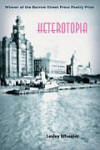Heterotopia
In Heterotopia, Lesley Wheeler considers the interactions of time and space—in particular, the space of Liverpool, England, and the time of her ancestor's lives, particularly her mother's, in that place.
In Heterotopia, Lesley Wheeler considers the interactions of time and space—in particular, the space of Liverpool, England, and the time of her ancestor's lives, particularly her mother's, in that place.
We are used to the reconfiguration of historic space in the work of African-American writers, and in writers from non-dominant cultures. However, by foregrounding her English cultural background, Wheeler points out that one must consider the specificities of any time and place, rather than treating culture as an assumption.
In the first section of this book, "Elsewhere," Wheeler outlines these multiple intersections. The title poem "Heterotopia," tells the story of Liverpool in short sections that move back in time from the narrator's mother through a poem bringing forth the connections between Liverpool and slavery, and ending with two short sections—one defining both the word, heterotopia, and project of the book, and the other reconnecting us to the narrator's relationship to her material:
I have no right to write,
no visa to any clouded
country. A poem
is a heterotopia
of citizenship: these
are my papers, counterfeit.
My countrywomen
are characters. I vote
in an obscure district.
I step through the glass
and leave white fingerprints
on the frame. I am sorry
for breaking things. I am
glad it is not real
to me. An accent
sounds like, but is not
really, a place to live.
Here, Wheeler draws attention to her uncertainties, and to the literary nature of what appears to be a biographical project.
The central poem of the book, "The Calderstones," is a near crown of sonnets which handles the formal constraints in a relaxed manner. In "The Calderstones," the poet connects present time to the mid-twentieth century past and on back through Liverpool's history. The formal nature of the project helps it seem as inevitable a part of the landscape as the Calderstones; however, even that is brought into question in some of the sonnets such as in the 13th where she writes:
…The tour
is slower than we expected, streets changed, backseat
choked with carsick children. We snap pictures
[…]The imagination works that way. A strong
emotion juiced with texture or a scent is better
than a memory: rosier, tarter, wetter.
These lines bring life to questions about the links between memory, imagination, and emotion. It expands from literal images of snapping pictures, to how the mind processes sensory images.
The final poem in Heterotopia, "The Forgetting Curve," connects this book directly to the process of memory, bringing in sensory and kinesthetic detail. It gives us much hope for our narrator, when after introducting a girl on a swing, Wheeler writes:
The first line on the graph falls almost plumb
with just a little forward kick at its base,
the kind a child makes one summer dusk,
…
as if the child is pumping now, leaning in
and back again in the rhythm that makes a swing
travel. It teaches a girl that if she dips
into the past, over the weedy paving stones,
the leggy pansies dimming, she will rock
with corresponding force into the future.
…
Maybe
the stars are flowers torn from a branch—
suspended in the blue breeze as notes
on a staff, preserved until they can be sung.
In Heterotopia, Lesley Wheeler recreates a time and a place, and connects that site to the present, singing of the Liverpool history she has uncovered.





